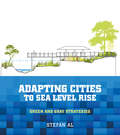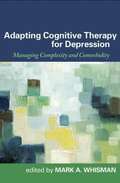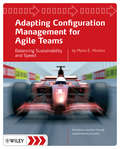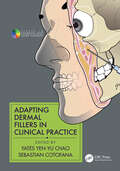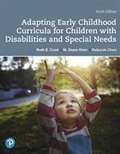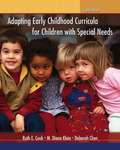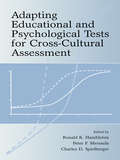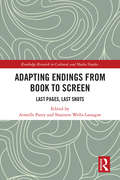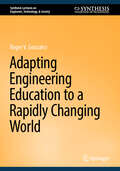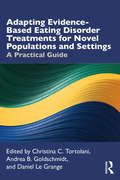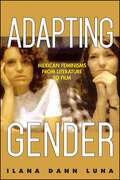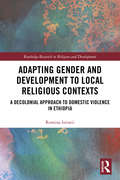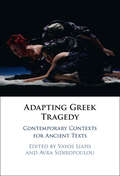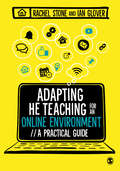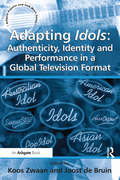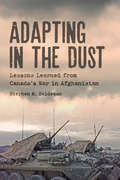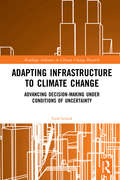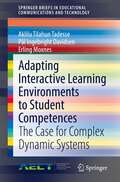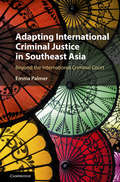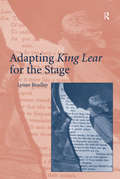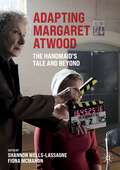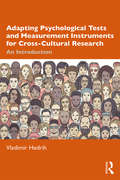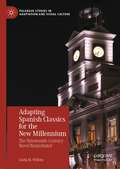- Table View
- List View
Adapting Cities to Sea Level Rise: Green and Gray Strategies
by Stefan AlIn 2012, Hurricane Sandy floods devastated coastal areas in New York and New Jersey. In 2017, Harvey flooded Houston. Today in Miami, even on sunny days, king tides bring fish swimming through the streets in low-lying areas. These types of events are typically called natural disasters. But overwhelming scientific consensus says they are actually the result of human-induced climate change and irresponsible construction inside floodplains.As cities build more flood-management infrastructure to adapt to the effects of a changing climate, they must go beyond short-term flood protection and consider the long-term effects on the community, its environment, economy, and relationship with the water. Adapting Cities to Sea Level Rise, by infrastructure expert Stefan Al, introduces design responses to sea-level rise, drawing from examples around the globe. Going against standard engineering solutions, Al argues for approaches that are integrated with the public realm, nature-based, and sensitive to local conditions and the community. He features design responses to building resilience that creates new civic assets for cities. For the first time, the possible infrastructure solutions are brought together in a clear and easy-to-read format.The first part of the book looks at the challenges for cities that have historically faced sea-level rise and flooding issues, and their response in resiliency through urban design. He presents diverse case studies from New Orleans to Ho Chi Minh to Rotterdam, and draws best practices and urban design typologies for the second part of the book. Part two is a graphic catalogue of best-practices or resilience strategies. These strategies are organized into four categories: hard protect, soft protect, store, and retreat. The benefits and challenges of each strategy are outlined and highlighted by a case study showing where that strategy has been applied.Any professional or policymaker in coastal areas seeking to protect their communities from the effects of climate change should start with this book. With the right solutions, Al shows, sea-level rise can become an opportunity to improve our urban areas and landscapes, rather than a threat to our communities.
Adapting Cities to Sea Level Rise: Green and Gray Strategies
by Stefan Al Edgar WesterhofAs cities build more flood-management infrastructure to adapt to the effects of a changing climate, they must go beyond short-term flood protection and consider the long-term effects on the community, its environment, economy, and relationship with the water.Adapting Cities to Sea Level Rise, by infrastructure expert Stefan Al, introduces design responses to sea-level rise, drawing from examples around the globe. Going against standard engineering solutions, Al argues for approaches that are integrated with the public realm, nature-based, and sensitive to local conditions and the community. He features design responses to building resilience that creates new civic assets for cities.With the right solution, Al shows, sea-level rise can become an opportunity to improve our urban areas and landscapes, rather than a threat to our communities.
Adapting Cognitive Therapy for Depression
by Mark WhismanWhile the efficacy of cognitive therapy for depression is well established, every clinician is likely to encounter patients who do not respond to "standard" protocols. In this highly practical volume, leading authorities provide a unified set of clinical guidelines for conceptualizing, assessing, and treating challenging presentations of depression. Presented are detailed, flexible strategies for addressing severe, chronic, partially remitted, or recurrent depression, as well as psychiatric comorbidities, medical conditions, and family problems that may complicate treatment. The book also offers essential knowledge and tools for delivering competent care to specific populations of depressed patients ethnic minorities; lesbian, gay, and bisexual people; adolescents; and older adults.
Adapting Configuration Management for Agile Teams
by Mario E. MoreiraAdapting Configuration Management for Agile Teams provides very tangible approaches on how Configuration Management with its practices and infrastructure can be adapted and managed in order to directly benefit agile teams. Written by Mario E. Moreira, author of Software Configuration Management Implementation Roadmap, columnist for CM Crossroads online community and writer for the Agile Journal, this unique book provides concrete guidance on tailoring CM for Agile projects without sacrificing the principles of Configuration Management.
Adapting Dermal Fillers in Clinical Practice (Series in Cosmetic and Laser Therapy)
by Yates Yen-Yu ChaoThere have been many different brands of dermal fillers approved for use for soft tissue augmentation in the US market alone, comprising four different types of temporary fillers and one permanent type, with several other brands and types also available elsewhere in the world. Against such a potentially bewildering variety and range of choices, this new text offers a scientific and an anatomic rationale for why a particular filler should be selected as optimal for each individual location and indication and how it should best be used in treatments. International experts share their clinical knowledge and expertise to guide all levels of esthetic practitioners toward the best results for each individual patient. CONTENTS: Fundamentals of Injectable Filler Procedures * Basic Injection Techniques * Modified and Advanced Injection Techniques * Novel Injection Techniques * Esthetic Filler Injection Pearls * Adapting Injection Techniques to Different Regions * Adapting Injection Techniques to Special Indications * Adapting Injection Techniques to Different Filling Materials * Adapting Injection Techniques to Different Genders * Adapting Injection Techniques to Different Age Groups * Adapting Injection Techniques to Patients of Different Ethnicity * Prevention and Management of Complications.
Adapting Early Childhood Curricula For Children With Special Needs
by Ruth Cook M. Klein Deborah ChenAdapting Early Childhood Curricula for Children with Disabilities and Special Needs uses a developmental focus, rather than a disability orientation, to discuss typical and atypical child development and curricular adaptations. The integrated, non-categorical approach assumes that children are more alike than different in their development. The inclusive focus assumes that attitudes, environments, and intervention strategies can be adapted so that all young children with disabilities or other special needs can be included. <p><p> An essential text for today, and a valuable resource to take into the classroom tomorrow, this practical guide provides daily activities, evidence-based how-to strategies, and realistic lesson modifications that help facilitate truly inclusive classrooms. Aspiring educators will also learn to develop their collaboration and problem-solving skills to effectively work with families, colleagues, and paraprofessionals in supporting every child's positive development. <p> The 10th Edition is updated to include enhanced discussions on working with families, children, and professionals of diverse cultural and linguistic backgrounds and lifestyles; new tips for integrating Division for Early Childhood Recommended Practices; updated requirements for writing IEP goals and recommendations; and more.
Adapting Early Childhood Curricula for Children with Special Needs (Eighth Edition)
by Ruth E. Cook M. Diane Klein Deborah ChenThe book focuses on a blend of developmental and learning theories, with practical suggestions for delivery of services to young children with special needs and their families.
Adapting Educational and Psychological Tests for Cross-Cultural Assessment
by Ronald K. Hambleton Peter F. Merenda Charles D. SpielbergerAdapting Educational and Psychological Tests for Cross-Cultural Assessment critically examines and advances new methods and practices for adapting tests for cross-cultural assessment and research. The International Test Commission (ITC) guidelines for test adaptation and conceptual and methodological issues in test adaptation are described in detail, and questions of ethics and concern for validity of test scores in cross-cultural contexts are carefully examined. Advances in test translation and adaptation methodology, including statistical identification of flawed test items, establishing equivalence of different language versions of a test, and methodologies for comparing tests in multiple languages, are reviewed and evaluated. The book also focuses on adapting ability, achievement, and personality tests for cross-cultural assessment in educational, industrial, and clinical settings. This book furthers the ITC's mission of stimulating research on timely topics associated with assessment. It provides an excellent resource for courses in psychometric methods, test construction, and educational and/or psychological assessment, testing, and measurement. Written by internationally known scholars in psychometric methods and cross-cultural psychology, the collection of chapters should also provide essential information for educators and psychologists involved in cross-cultural assessment, as well as students aspiring to such careers.
Adapting Endings from Book to Screen: Last Pages, Last Shots (Routledge Research in Cultural and Media Studies)
by Armelle Parey Shannon Wells-LassagneThis book offers a new perspective on adaptation of books to the screen; by focusing on endings, new light is shed on this key facet of film and television studies. The authors look at a broad range of case studies from different genres, eras, countries and formats to analyse literary and cinematic traditions, technical considerations and ideological issues involved in film and television adaptions. The investigation covers both the ideological implications of changes made in adapting the final pages to the screen, as well as the aesthetic stance taken in modifying (or on the contrary, maintaining) the ending of the source text. By including writings on both film and television adaptations, this book examines the array of possibilities for the closure of an adapted narrative, focusing both on the specificities of film and different television forms (miniseries and ongoing television narratives) and at the same time suggesting the commonalities of these audiovisual forms in their closing moments. Adapting Endings from Book to Screen will be of interest to all scholars working in media studies, film and television studies, and adaptation studies.
Adapting Engineering Education to a Rapidly Changing World (Synthesis Lectures on Engineers, Technology, & Society)
by Roger V. GonzalezRapid technological advancements, globalization, and environmental concerns impact the role of engineers in today’s society. The book emphasizes the role and contribution of engineers to society, and the importance of engineering education. However, to better prepare engineers, for the challenges and opportunities of their profession, engineering education must change. This book begins by comparing the systems of engineering education in the United States and the United Kingdom, in terms of program structure, students, academics/faculty, and external factors. This comparison provides context to the discussion of the leadership role engineers should play and how engineering education should prepare students for leadership. The focus of the second part of the book is on the important role of professional development in engineering education and on broadening access to and participation in these programs. The author explains that engineering education programs must be redesigned to meet industry needs and to allow future engineers to achieve career success. To do so, in addition to traditional topics in science and engineering, programs should help students develop professional and managerial skills including communication, project management, analytical, and problem-solving skills. The final part of the book is dedicated to exploring how accelerated technological developments including artificial intelligence, require that engineering programs adapt, in order to remain relevant.
Adapting Evidence-Based Eating Disorder Treatments for Novel Populations and Settings: A Practical Guide (A\hodder Arnold Publication)
by David Enoch Basant K. Puri Hadrian BallThis comprehensive text provides practical approaches to adapting empirically supported treatments for eating disorders for clinicians working with patients of diverse backgrounds and presentations, or within non-traditional treatment settings across levels of care. The book describes empirically- and clinically-informed treatment adaptations that impact delivery of real-world services for eating disorder patients and generate interest in testing adapted treatments in randomized controlled trials. Featuring contributions from researchers and clinicians with expertise in developing, delivering, and testing interventions for eating disorders, each chapter focuses on a specific population, setting, or training approach. Practical applications are then illustrated through case examples and wisdom gleaned through the contributors’ own clinical studies and experiences. Readers working with a diverse population of eating disorder patients will gain the necessary skills to support their patients on the journey to recovery and self-acceptance.
Adapting Gender: Mexican Feminisms from Literature to Film (SUNY series in Latin American Cinema)
by Ilana Dann LunaAdapting Gender offers a cogent introduction to Mexico's film industry, the history of women's filmmaking in Mexico, a new approach to adaptation as a potential feminist strategy, and a cultural history of generational changes in Mexico. Ilana Dann Luna examines how adapted films have the potential to subvert not only the intentions of the source text, but how they can also interrupt the hegemony of gender stereotypes in a broader socio-political context. Luna follows the industrial shifts that began with Salinas de Gortari's presidency, which made the long 1990s the precise moment in which subversive filmmakers, particularly women, were able to participate more fully in the industry and portrayed the lived experiences of women and non-gender-conforming men. The analysis focuses on Busi Cortés's El secreto de Romelia (1988), an adaptation of Rosario Castellanos's short novel El viudo Román (1964); Sabina Berman and Isabelle Tardán's Entre Pancho Villa y una mujer desnuda (1996), an adaptation of Berman's own play, Entre Villa y una mujer desnuda (1992); Guita Schyfter's Novia que te vea (1993), an adaptation of Rosa Nissán's eponymous novel (1992); and Jaime Humberto Hermosillo's De noche vienes, Esmeralda (1997), an adaptation of Elena Poniatowska's short story "De noche vienes" (1979). These adapted texts established a significant alternative to monolithic notions of national (gendered) identity, while critiquing, updating, and even queering, notions of feminism in the Mexican context.
Adapting Gender and Development to Local Religious Contexts: A Decolonial Approach to Domestic Violence in Ethiopia (Routledge Research in Religion and Development)
by Romina IstratiiThis book provides a critical and decolonial analysis of gender and development theory and practice in religious societies through the presentation of a detailed ethnographic study of conjugal violence in Ethiopia. Responding to recent consensus that gender mainstreaming approaches have failed to produce their intended structural changes, Romina Istratii explains that gender and development analytical and theoretical frameworks are often constructed through western Euro-centric lenses ill-equipped to understand gender-related realities and human behaviour in non-western religious contexts and knowledge systems. Instead, Istratii argues for an approach to gender-sensitive research and practice which is embedded in insiders’ conceptual understandings as a basis to theorise about gender, assess the possible gendered underpinnings of local issues and design appropriate alleviation strategies. Drawing on a detailed study of conjugal abuse realities and attitudes in two villages and the city of Aksum in Northern Ethiopia, she demonstrates how religious knowledge can be engaged in the design and implementation of remedial interventions. This book carefully evidences the importance of integrating religious traditions and spirituality in current discussions of sustainable development in Africa, and speaks to researchers and practitioners of gender, religion and development in Africa, scholars of non-western Christianities and Ethiopian studies, and domestic violence researchers and practitioners.
Adapting Greek Tragedy: Contemporary Contexts for Ancient Texts
by Vayos Liapis Avra SidiropoulouAdaptations of Greek tragedy are increasingly claiming our attention as a dynamic way of engaging with a dramatic genre that flourished in Greece some twenty-five centuries ago but remains as vital as ever. In this volume, fifteen leading scholars and practitioners of the theatre systematically discuss contemporary adaptations of Greek tragedy and explore the challenges and rewards involved therein. Adopting a variety of methodologies, viewpoints and approaches, the volume offers surveys of recent developments in the field, engages with challenging theoretical issues, and shows how adapting Greek tragedy can throw new light on a range of contemporary issues — from our relation to the classical past and our shifting perceptions of ethnic and cultural identities to the place, function and market-value of Greek drama in today's cultural industries. The volume will be welcomed by students and scholars in Classics, Theatre, Drama and Performance Studies, as well as by theatre practitioners.
Adapting Higher Education Teaching for an Online Environment: A practical guide
by Rachel Stone Ian GloverFor busy academics of all subject disciplines who have been asked to convert their face to face teaching into an online model of delivery. The chapters present the steps that need to be taken to design and facilitate a high quality learning experience for students using a variety of modes and media. Each chapter includes a task and a checklist designed to help the reader through the transition process, covering such aspects as tools, structure, presentations, live and ‘on demand’ teaching, assessment, ideas for activities, inclusion and trouble-shooting.
Adapting Higher Education Teaching for an Online Environment: A practical guide
by Rachel Stone Ian GloverFor busy academics of all subject disciplines who have been asked to convert their face to face teaching into an online model of delivery. The chapters present the steps that need to be taken to design and facilitate a high quality learning experience for students using a variety of modes and media. Each chapter includes a task and a checklist designed to help the reader through the transition process, covering such aspects as tools, structure, presentations, live and ‘on demand’ teaching, assessment, ideas for activities, inclusion and trouble-shooting.
Adapting Idols: Authenticity, Identity And Performance In A Global Television Format (Ashgate Popular and Folk Music Series)
by Joost de BruinSince the first series of Pop Idol aired in the UK just over a decade ago, Idols television shows have been broadcast in more than forty countries all over the world. In all those countries the global Idols format has been adapted to local cultures and production contexts, resulting in a plethora of different versions, ranging from the Dutch Idols to the Pan-Arab Super Star and from Nigerian Idol to the international blockbuster American Idol. Despite its worldwide success and widespread journalistic coverage, the Idols phenomenon has received only limited academic attention. Adapting Idols: Authenticity, Identity and Performance in a Global Television Format brings together original studies from scholars in different parts of the world to identify and evaluate the productive dimensions of Idols. As one of the world's most successful television formats, Idols offers a unique case for the study of cultural globalization. Chapters discuss how Idols shows address particular national or regional identity politics and how Idols is consumed by audiences in different territories. This book illustrates that even though the same television format is used in countries all over the globe, practices of adaptation can still result in the creation of unique local cultural products.
Adapting in the Dust
by Stephen M. SaidemanCanada's six-year military mission in Afghanistan's Kandahar province was one of the most intense and challenging moments in Canadian foreign affairs since the Korean War. A complex war fought in an inhospitable environment, the Afghanistan mission tested the mettle not just of Canada's soldiers but also of its politicians, public servants, and policy makers. In Adapting in the Dust, Stephen M. Saideman considers how well the Canadian government, media, and public managed the challenge.Building on interviews with military officers, civilian officials, and politicians, Saideman shows how key actors in Canada's political system, including the prime minister, the political parties, and parliament, responded to the demands of a costly and controversial mission. Some adapted well; others adapted poorly or - worse yet - in ways that protected careers but harmed the mission itself.Adapting in the Dust is a vital evaluation of how well Canada's institutions, parties, and policy makers responded to the need to oversee and sustain a military intervention overseas, and an important guide to what will have to change in order to do better next time.
Adapting Infrastructure to Climate Change: Advancing Decision-Making Under Conditions of Uncertainty (Routledge Advances in Climate Change Research)
by Todd SchenkMany of the challenges that decision-makers grapple with in relation to climate change are governance related. Planning and decision-making is evolving in ambiguous institutional environments, in which many key issues remain unresolved, including relationships between different actors; funding arrangements; and the sources and procedures for vetting data. These issues are particularly acute at this juncture, as climate adaptation moves from broad planning processes to the management of infrastructure systems. Concrete decisions must be made. Adapting Infrastructure to Climate Change draws on case studies of three coastal cities situated within very different governance regimes: neo-corporatist Rotterdam, neo-pluralist Boston and semi-authoritarian Singapore. The book examines how infrastructure managers and other stakeholders grappling with complex and uncertain climate risks are likely to make project-level decisions in practice, and how more effective decision-making can be supported. The differences across governance regimes are currently unaccounted for in adaptation planning, but are crucial as best practices are devised. These lessons are also applicable to infrastructure planning and decision-making in other contexts. This book will be of great interest to scholars of climate change and environmental policy and governance, particularly in the context of infrastructure management.
Adapting Interactive Learning Environments to Student Competences: The Case for Complex Dynamic Systems (SpringerBriefs in Educational Communications and Technology)
by Aklilu Tilahun Tadesse Pål Ingebright Davidsen Erling MoxnesThis monograph focuses on the design of personalized and adaptive online interactive learning environment (OILE) to enhance students’ learning in and about complex dynamic systems (CDS). Numerous studies show that students experience difficulties when learning in and about CDS. The difficulties are due to challenges originating from a) the structural complexity of CDS, (b) the production of dynamic behavior from the underlying systems structure, and (c) methods, techniques and tools employed in the analysis of such systems. Despite the fact that studies have uncovered such learning challenges, it is still not well understood how we may effectively address these challenges. In this monograph, the authors provide some answers as to how we may best improve our cognitive capabilities to meet these challenges by way of effective instructional methods, techniques, and tools and their implementation in the form of an OILE. The OILE developed for this purpose, builds on a five-step holistic instructional design framework; identification of instructional design models, identification of authentic learning material, identification of instructional methods, identification of instructional techniques, and design of the interface and implementation of the tool. In this OILE development, six well-documented instructional design models were considered; a four component instructional design, first principles of instruction, constructivists learning environment, task centered instruction, cognitive apprenticeship, and elaboration theory.
Adapting International Criminal Justice in Southeast Asia: Beyond the International Criminal Court
by Emma PalmerHow is international criminal law adapted across time and space? Which actors are involved and how do those actors seek to prosecute atrocity crimes? States in Southeast Asia exhibit a range of adapted approaches toward prosecuting international crimes. By examining engagement with international criminal justice especially in Cambodia, the Philippines, Indonesia, and Myanmar, this book offers a fresh and comprehensive approach to the study of international criminal law in the region. It nuances categories of the 'global' and 'local' and demonstrates how norms can be adapted in multiple spatial and temporal directions beyond the International Criminal Court. It proposes a shift in the focus of those interested in international criminal justice toward recognising the opportunities and expertise presented by existing adaptive responses to international crimes. This book will appeal to scholars, practitioners and advocates interested in international criminal law, international relations, transitional justice, civil society, and law in Southeast Asia.
Adapting King Lear for the Stage
by Lynne BradleyQuestioning whether the impulse to adapt Shakespeare has changed over time, Lynne Bradley argues for restoring a sense of historicity to the study of adaptation. Bradley compares Nahum Tate's History of King Lear (1681), adaptations by David Garrick in the mid-eighteenth century, and nineteenth-century Shakespeare burlesques to twentieth-century theatrical rewritings of King Lear, and suggests latter-day adaptations should be viewed as a unique genre that allows playwrights to express modern subject positions with regard to their literary heritage while also participating in broader debates about art and society. In identifying and relocating different adaptive gestures within this historical framework, Bradley explores the link between the critical and the creative in the history of Shakespearean adaptation. Focusing on works such as Gordon Bottomley's King Lear's Wife (1913), Edward Bond's Lear (1971), Howard Barker's Seven Lears (1989), and the Women's Theatre Group's Lear's Daughters (1987), Bradley theorizes that modern rewritings of Shakespeare constitute a new type of textual interaction based on a simultaneous double-gesture of collaboration and rejection. She suggests that this new interaction provides constituent groups, such as the feminist collective who wrote Lear's Daughters, a strategy to acknowledge their debt to Shakespeare while writing against the traditional and negative representations of femininity they see reflected in his plays.
Adapting Margaret Atwood: The Handmaid's Tale and Beyond (Palgrave Studies in Adaptation and Visual Culture)
by Shannon Wells-Lassagne Fiona McMahonThis book engages with Margaret Atwood’s work and its adaptations. Atwood has long been appreciated for her ardent defence of Canadian authors and her genre-bending fiction, essays, and poetry. However, a lesser-studied aspect of her work is Atwood’s role both as adaptor and as source for adaptation in media as varied as opera, television, film, or comic books. Recent critically acclaimed television adaptations of the novels The Handmaid’s Tale (Hulu) and Alias Grace (Amazon) have rightfully focused attention on these works, but Atwood’s fiction has long been a source of inspiration for artists of various media, a seeming corollary to Atwood’s own tendency to explore the possibilities of previously undervalued media (graphic novels), genres (science-fiction), and narratives (testimonial and historical modes). This collection hopes to expand on other studies of Atwood’s work or on their adaptations to focus on the interplay between the two, providing an interdisciplinary approach that highlights the protean nature of the author and of adaptation.
Adapting Psychological Tests and Measurement Instruments for Cross-Cultural Research: An Introduction
by Vladimir HedrihAdapting Psychological Tests and Measurement Instruments for Cross-Cultural Research provides an easy-to-read overview of the methodological issues and best practices for cross-cultural adaptation of psychological instruments. Although the development of cross-cultural test adaption methodology has advanced in recent years, the discussion is often pitched at an expert level and requires an advanced knowledge of statistics, psychometrics and scientific methodology. This book, however, introduces the history and concepts of cross-cultural psychometrics in a pedagogic and simple manner. It evaluates key ethical, cultural, methodological and legal issues in cross-cultural psychometrics and provides a guide to test adaptation, data analysis and interpretation. Written in an accessible manner, this book builds an understanding of the methodological, ethical and legal complexities of cross-cultural test adaptation and presents methods for test adaptation, including the basic statistical procedures for evaluating the equivalence of test versions. It would be the ideal companion for undergraduate students and those new to psychometrics.
Adapting Spanish Classics for the New Millennium: The Nineteenth-Century Novel Remediated (Palgrave Studies in Adaptation and Visual Culture)
by Linda M. WillemThe twenty-first-century's turn away from fidelity-based adaptations toward more innovative approaches has allowed adapters from Spain, Argentina, and the United States to draw upon Spain's rich body of nineteenth-century classics to address contemporary concerns about gender, sexuality, race, class, disability, celebrity, immigration, identity, social justice, and domestic violence. This book provides a snapshot of visual adaptations in the first two decades of the new millennium, examining how novelistic material from the past has been remediated for today's viewers through film, television, theater, opera, and the graphic novel. Its theoretical approach refines the binary view of adapters as either honoring or opposing their source texts by positing three types of adaptation strategies: salvaging (which preserves old stories by giving them renewed life for modern audiences), utilizing (which draws upon a pre-existing text for an alternative purpose, building upon the story and creating a shift in emphasis without devaluing the source material), and appropriation (which involves a critique of the source text, often with an attempt to dismantle its authority). Special attention is given to how adapters address audiences that are familiar with the source novels, and those that are not. This examination of the vibrant afterlife of classic literature will be of interest to scholars and educators in the fields of adaptation, media, Spanish literature, cultural studies, performance, and the graphic arts.
